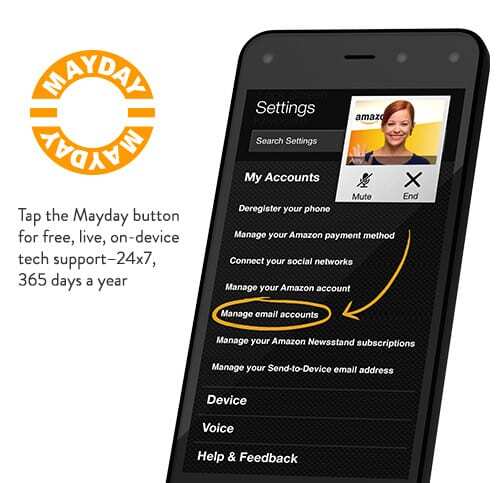Amazon Fire Phone brings with it some serious insights about the power WebRTC has.

If you search the web, you’ll see a lot of criticism about the new Amazon Fire Phone. Most expected it to be cheaper. Others think the 3D part is too gimmicky. Most predictions for now are around failure for the Amazon Fire Phone. I don’t have any solid opinion.
Almost two years ago, on my birthday, I asked for an aPhone. Now it is here.
The new things introduced in this phone compared to the rest of the pack?
- Dynamic perspective, which tracks the user’s face and adjust the display’s perspective to match. This should give a kind of a depth/3D feel to it
- Firefly, enabling to point the camera at anything and… buy it (or do other things about it)
- Mayday, same as their Fire tablet – instant connectivity via video to a contact center agent
I have written about Mayday before, while looking at the Kindle Fire Tablet. Time to see where we are with it, now that it is headed to a smartphone.
Taking a closer look at the Fire Phone, there are several good lessons there for those in the communication space – especially those interested in WebRTC.
Who provides customer care?
If you buy a Fire Phone, and you bump into an issue. Who would you contact to ask/complain? The carrier, or Amazon?
It will be Amazon.
I don’t know the phone number for the contact center of my carrier. I need to search for it on the web. And I already know they are going to have me on hold for minutes if not hours.
With Amazon? There’s an immediate button on the device. You click it. It connects you to an agent.
Assume this would have been an iPhone and not a Fire Phone. What would happen then to the connection and “ownership” of the customer? Who would be the first line of support for customers?
This is the first smartphone out there where the contact center of the phone belongs to the handset manufacturer and NOT the carrier.
It is also why this phone is rolled exclusively only on AT&T and no other network – getting this to work out of North America, with the same set of expectations from the Amazon contact center is something that will take time for Amazon to ready itself for.
Do we need to rethink the contact center?
What is the average wait for a carrier’s contact center? For Amazon, that’s less than 10 seconds:
The average Amazon response time to those calls for help is 9.75 seconds.
That’s unheard of. It is also 30% less than Amazon’s target for this service.
The benefits gained from using Mayday over any other contact center solution?
- Short wait time
- No need to provide subscriber information – context provided from using Mayday itself
- Seeing the agent, and not just hearing him
- Ability to share the screen of the device to explain better the issue at hand
- Ability for the agent to annotate and control the device remotely to explain things to the user
This is a totally new experience.
Did Google miss their own boat of mobile first for WebRTC?
Looking around, there are 4 smartphones today that should have WebRTC:
- Google’s Android. Being Google’s, you’d assume it will already have WebRTC. But it doesn’t
- Chrome on Android isn’t there by default, so I am ignoring it
- Webviews on Android, even if Chrome based, don’t support WebRTC (yet)
- Google Hangouts – you need to install it to say you have WebRTC there (somewhere and somehow)
- Samsung’s Tizen, which documentation suggests that it has. Without any other confirmation, I’ll skip this one (it also isn’t that important as an OS and a platform yet)
- Mozilla’s Firefox OS, which starts shipping. Based on HTML5 and Firefox, you’d assume it will have WebRTC. Since I’ve seen no indication to it yet, I’ am ignoring it
- Amazon’s Fire Phone, which comes with Mayday built-in
To date, WebRTC on mobile has been a distant dream.
We can’t be sure if the Fire Phone has or hasn’t included WebRTC capabilities into its web browser or webviews, but I think it is safe to say it haven’t. But it beat everyone else into embedding a WebRTC based service at the heart of a smartphone – and doing so in a way that potentially changes the way we look at contact centers.
WebRTC should have been a mobile first initiative. A lot of the use cases out there are focusing on mobile only or mobile first at the moment – even with the abysmal support we have there (it is way better than without having WebRTC, but it is far from the comfortable environment we now have on PC browsers).
Amazon beat the rest in exploiting WebRTC – something I’ve explained a couple of months ago.
The interesting thing, is that they are doing that with very little activity and participation in the WebRTC ecosystem itself.
Why is it important?
WebRTC is a disruptive technology.
Companies need to rethink their approach to communications and understand how WebRTC can assist or threaten their current business model.
For now, Amazon is one of the top players in WebRTC.

Hi Tsahi,
Regarding your comment on Mozilla Firefox OS – WebRTC is available on Firefox OS.
We support DataChannel, getUserMedia and PeerConnection for audio and video since 1.4 and we’re bringing H264 hardware support in 2.0 !
Our roadmap is public – https://wiki.mozilla.org/B2G/Roadmap
Thanks for the update Romain.